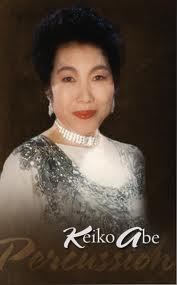Abe, Keiko
Biography
Name in Chinese: 安倍圭子
Born: April 18, 1937
Country: Japan
Studies: Tokyo Gakugei University (1961)
Website: http://www.keiko-abe.com/englishindex.html
Mention: Inducted into the Percussive Arts Society (1993) PAS Hall of Fame[1]
Great Musicians have been linked with their instruments throughout the history of music. We are truly fortunate to be able to hear and experience the artistry of Keiko Abe playing marimba. Audiences hearing her performance for the first time are often astonished by the modern marimba’s wealth of tonal nuances and by the tremendous scope of Abe’s creativity and musicianship. Keiko Abe has the ability to merge with her marimba: the resulting union produces music with incredible depth of feeling. She represents a perfect combination of virtuoso technique and passionate artistry.
Keiko Abe has developed her position as a world-class musician thanks to a rare combination of creative power, acute sensitivity and virtuosic technique. She commands an overwhelming repertoire and appears regularly throughout the world in performances of solo concertos, chamber music, and improvisations. She is also in demand as a guest lecturer and has given master-classes in leading music conservatories in North America, Central and South America, Europe, and Asia.
In addition, she has recorded extensively on the Denon label, and has received numerous awards, including induction into the Percussive Arts Society Hall of Fame Award. Keiko Abe’s compositions have become some of the standards of marimba literature and can be heard in recitals by marimbists all over the world. Many modern composers have also dedicated new works to her; she has inspired and premiered countless new compositions.
By both pioneering new technical skills and expanding the literature, Keiko Abe has transformed what was once considered a primitive “Folk” instrument into a full-fledged concert instrument welcome in any of the most prestigious concert halls. In addition to her work as Professor of Marimba at Toho Gakuen School of Music in Tokyo, Abe maintains a full schedule of composing and touring.[2]
Works for Percussion
Alone - Marimba
Ancient Letter - Marimba
Ancient Vase - Marimba
Aqua-Harmonia based on "Memories of the Seashore" - Marimbas (8) - Abe/Natsume
Autumn in Nara - Marimbas (2) - Abe/Samuels
Ban-ka - Marimba
Ban-ka for 4 players - Marimba Trio; Saxophone
Ban-ka for solo marimba and percussion group - Marimba; Percussion Ensemble
Conversation in the Forest for Ensemble and Gamran Jegog - Marimba Ensemble; Percussion Trio; Gamran Jegog
Conversation in the Forest for Marimba Ensemble - Marimba Ensemble
Conversation in the Forest for Two Marimbas - Marimbas (2)
Conversation in the Forest I - Marimba; Percussion Trio
Conversation in the Forest II - Marimba, Percussion (2); Saxophone; Oboe
Conversation in the Forest III - Marimba; Percussion Quartet
Dream - Marimbas (2) - Abe/Samuels
Dream of the Cherry Blossoms - Marimba
Early Spring - Marimba (2) - Abe/Samuels
Frogs - Marimba
In Praise of Nature - Marimba; with tape
Itsuki Fantasy for Six Mallets - Marimba
Labyrinth - Marimbas (2) - Abe/Samuels
Little Windows - Marimba
Marimba Concertino - The Wave - Marimba; Percussion Quartet
Marimba d'Amore - Marimba
Memories of the Seashore - Marimba
Memories of the Seashore for Marimba Ensemble - Marimba Ensemble
Memories of the Seashore for Two Marimbas - Marimbas (2)
Memories of the Seashore Ⅱ - Marimbas (2)
Michi - Marimba
Michi II - Marimba
Prism for Solo Marimba - Marimba
Prism for Two Marimbas - Marimba (2)
Prism Rhapsody for Marimba and Orchestra - Marimba; Orchestra
Prism Rhapsody for Marimba and Piano - Marimba; Piano
Prism Rhapsody for Marimba and Wind Ensemble - Marimba; Wind Ensemble
Prism Rhapsody II for 2 marimbas and 6 Percussionists - Marimba (2); Percussion Sextet
Prism Rhapsody II for 2 marimbas and orchestra - Marimba (2); Orchestra
Prism Rhapsody II for 2 marimbas and piano - Marimba Concerto - Marimba (2); Piano
Prism Rhapsody II for 2 marimbas and wind ensemble - Marimba (2); Wind Ensemble
Prism Rhapsody, 2nd Edition - Marimba; Orchestra or Wind Ensemble
Prism Variations for Marimba Ensemble and Percussionist - Marimba Ensemble; Percussion Ensemble
Reflections on Japanese Children's Songs II - Marimba (2); Percussion
Reflections on Japanese Children's Songs II for Two Marimbas - Marimba (2)
Reflections on Japanese Children's Songs III - for Marimba Ensemble and 2 Percussionists - Marimba Ensemble, Percussion Duo
Reflections on Japanese Children's Songs III - for Two Marimbas and Percussionist - Marimba (2), Percussion
She Dies, My Water Lily Tonneke - Marimba (2) - Abe/Van Hauwe
Sunday Afternoon - Marimba (2) - Abe/Samuels
Sylvan Stanzas (Mountain Stanzas) - Marimba
Sylvan Stroll - Marimba (2) - Abe/Samuels
Tambourin Paraphrase for Marimba Ensemble - Marimba Ensemble (5)
Tambourin Paraphrase for Solo Marimba - Marimba
Tambourin Paraphrase for Two Marimbas - Marimba (2)
Three Monologues - Marimba
Torrent - Marimba (2) - Abe/van Hauwe
Variations on Japanese Children Songs - Marimba
Voice of Matsuri Drums - Marimba
Wave Impression - Marimba Ensemble; Percussion (2)
Wind Across Mountains for Marimba Ensemble - Marimba Ensemble
Wind Across Mountains for solo marimba - Marimba
Wind Across Mountains for Two Marimbas - Marimba (2)
Wind Across the Mountains for Six Mallets - Marimba
Wind in the Bamboo Grove - Marimba
Wind in the Bamboo Grove for Two Marimbas - Marimba (2)
Wind Sketch - Marimba
Wind Sketch II for 2 Marimbas - Marimba (2)
Wind Sketch II for Marimba and Percussion - Marimba; Percussion Ensemble (26)
Wind Sketch III - Marimba; Percussion Duo
Wind Sketch IV for Marimba and Percussion - Marimba (2); Percussion (2)
Works For Marimba - Marimba
References
- ↑ PAS.org Accessed March 23, 2013
- ↑ http://www.keiko-abe.com
- Composers
- Japanese Composers
- Female Composers
- History
- History-Composers
- History-Performers
- Percussion Ensemble
- Solo Percussion
- Marimba
- Marimba Duet
- Marimba Ensemble
- Percussion Duet
- Percussion Duo
- Percussion (2)
- Percussion Quartet
- Percussion (4)
- Percussion (20+)
- With Tape
- Saxophone
- Oboe
- Orchestra
- Piano
- Six Mallets
- Concerto
- Marimba Concerto
- Wind Ensemble
- PAS Hall of Fame
